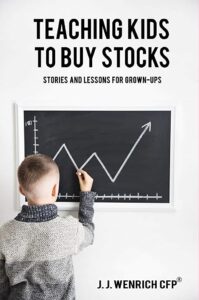Teaching Kids to Buy Stocks: Interview with Author J.J. Wenrich by Melissa Couch Salim
 Why were you passionate about writing a book on this topic? So many reasons!!
Why were you passionate about writing a book on this topic? So many reasons!!
First off, I was fortunate to have teachers growing up that taught us about the basics of the stock market, and a little personal finance as well. I am very grateful for the exposure to these topics, as they ended up inspiring my career.
Second, these are lessons worth teaching. Helping someone learn how to save and invest their money for a rainy day is LIFE CHANGING BEHAVIOR. These aren’t math lessons either, they are BEHAVIOR LESSONS. As important as they are, these lessons aren’t taught consistently in many homes and schools.
Over the course of my career, I discovered that “Finance Types” often do a terrible job of explaining the markets to “Non Finance Types”… …I’m not pointing the finger, I’m guilty of this too! We make it more complicated that it needs to be. It was only after watching enough people’s eyes glaze over while I was speaking (as well as some constructive feedback) that I realized what I was doing.
My goal with the book is to take the lessons I’ve learned from working with professional financial advisors and their retail clients, as well as the lessons from teaching my own kids the basics of the stock market and personal finance, and combine them into a “FINANCE BOOK FOR PEOPLE WHO DON’T READ FINANCE BOOKS”.
I wanted it to read like a “Mom Book” or “Dad Book”, but also have enough meat in the lessons to stand up to professional and academic standards relative to analyzing stocks. In the end, I walk readers into MBA level course on investment theory, but attempt to do so with a “Neighborhood Lemonade Stand” wrapper.
At what age should parents begin teaching their kids about money and the importance of saving? As soon as you’ve figured out how to keep the baby from putting coins in her/his mouth, begin teaching them about money next!
The lessons grow with the kids…start early with simple lessons, and work your way up. The most important thing you can do is TALK. Talk about how much things cost in your life, their life, etc. Talk about how it takes effort to save, to delay gratification when you get money. It’s not a class you teach – it’s what you do as you live your life. Just like you taught them to look both ways by taking them to the street – you have to teach them as you are spending, shopping, bargain hunting, saving, investing….
Money Management and Buying Stocks is a big topic. How should parents begin to prioritize the money lessons? The most important lesson is learning to save. It’s hard. That’s why most grown-ups struggle with it, too.
It doesn’t do you much good to know how to pick stocks if you don’t have any money to buy them. Also, if you don’t have an emergency fund before investing, you set yourself up for failure.
People who can’t resist the temptation to spend, don’t often have emergency funds. If you haven’t proven to have the mental fortitude necessary to save and keep an emergency fund, you probably won’t have the mental fortitude to be a successful long-term investor either.
The MATH IS EASY – it is THE PSYCHOLOGY THAT IS HARD!!
How did you get introduced to the Stock Market? I love the Mrs. Brown story in the book! I was introduced to the stock market by Tom Brokaw and NBC Nightly News…. By Mrs. Brown in 7th Grade…. And by (the late) Professor Mark Hirschey at the University of Kansas. Both of the teachers had a way of making the markets seem both interesting and intriguing, but also approachable. That’s what I wanted my book to be as well.
I also love the idea of telling your own kids that if they save $500.00, you will match it. What an incentive and isn’t that what started their interest? The savings contest gave us a way to help motivate them to save – the help get them through that psychological hurdle of delayed gratification.
I’m not sure if it was the $500 reward, or sibling rivalry that was the true motivator, honestly. Competition can push some people to limits they wouldn’t reach on their own.
I can tell one kid “Run Up that Hill,” and he/she will get tired halfway and stop. If I tell two kids “Race up that hill” – they will run until they can’t breathe and try to crawl up to win the race. At least they would when they were young… now they just tell me to go away.
Talk to us about “Hot Tips” vs. listening to our brokers or experts in the field. This is a great “TIP” for adults! This is important! “Hot Tips” and “Sure Things” have been around longer any of us… And not all brokers, advisors, researchers are created equally.
This blog post might be helpful too… it addresses some of this.
https://www.teachingkidstobuystocks.com/post/reddit-the-rumor-mill-or-research-where-should-one-go-for-investment-advice
Approach the investment world and advice industry with a healthy amount of skepticism towards anyone that makes it sound too quick and easy to make money.
In my opinion, it comes down to this: Know where you are getting your research, and where your researcher is getting their research… It is a balancing act to sift through the hype machines in mainstream financial journalism, while avoiding the dark corners that don’t look like dark corners to the untrained eye.
If you are taking a recommendation, who is it from? How long have you been following their advice? Do you know others who have followed their advice, and for how long? It’s ok to question professionals if you don’t understand. In fact, it is ENCOURAGED.
The biggest danger I see, is when someone takes a tip from an article, tweet, post, etc. without having done their own homework, and without having known or followed that person for a length of time to know their style, pattern of advice. That advice may be perfectly fine for one person, but not for another. If you don’t know how to differentiate between the two, you shouldn’t probably be taking the tip.
It’s also EXTREMELY IMPORTANT to differentiate between TRADING and INVESTING. They aren’t the same thing.
Trading implies more frequent buying and selling in an attempt to capture shorter-term gains, whereas investing implies less frequent buying and selling as well as longer holding periods. Trading is more akin to gambling, whereas investing is more akin to buying a business.
What are some fun games and/or apps we can show our kids to make learning money management fun for them? BusyKid is an app that is perfect for incorporating personal finance and investing lessons with kids. It allows you to set up chores, allowance, spending, saving, giving, and investing. Kids get a debit card that they can use, allowing them to spend money at stores and online, while managing an account balance.
Investor Showdown is an independently created game that is SUPER SIMPLE but SUPER FUN. It helps teach kids about real estate, stocks, bonds, funds, etc. in a somewhat Monopoly-like game that only takes about 20 minutes to play.
Build Your Stax is a fun online investment simulator game that can be played individually or in a group. It uses historical market data to create a simulated investment environment for players to navigate through the ups and downs, the buys and sells.
We are excited about a new “fin-lit-tech” product coming out soon, called the Life Hub Learning Center. This looks to be a fantastic tool for helping families support financial and entrepreneurial education and exploration in their children.
At your home, you turned chores and allowance into a business for your kids. How did that work, and was it successful?
The way we put is this… There are certain things in life you have to do as a responsible person. They aren’t always fun, but they need to happen for life to flow. If you don’t clean your clothes, your clothes won’t be clean, right? Therefore, as responsible adults, we “handle our business” and take time to clean our clothes.
That’s what we’re teaching the kids by giving them household responsibilities. As my wife puts it, we’re trying to teach them to be good future roommates, spouses, employees, employers, leaders, etc. “Handle your business. Handle your affairs. Don’t drop the ball.”
Honestly, it often feels like complete failure lately when it comes to chores, taking care of business, etc. I have three normal teens, and it’s not easy to keep them on track with their grades and being responsible. It was easier when they were younger.
That being said, I’ve been happy to see them have varying degrees of success saving and investing money. I know who my spenders are – and I know who my savers are!!
I love your “SHARE SAVE SPEND” motto. Will you share? We encourage adults to talk about money with kids, but not in a “greed” driven way, but in a socially responsible way.
Three things you can do with your money… and all three are important to be balanced.
First, it’s easier to be a blessing to others, if you aren’t a financial mess yourself. How can you help lift others if you can’t lift yourself? Therefore, it is important to live in a way that allows you to save your money, as well as spend it… But it doesn’t stop there.
We believe in expressing our gratitude for the gifts in our life, by sharing out time and money when we have it (and sometimes when we don’t).
What you give comes back to you.. sometimes financially, sometimes in the form of joy, energy, knowledge, perspective, a relationship, or spiritually… we don’t know how, but it happens. Selfishly, you get something out of sharing… But that shouldn’t be the only reason to do it, obviously.
Plus, the more people care about other people, the better we do as a society.

J. J. is a 20-year veteran of the investment world. He is known for simplifying complex concepts in a fun and approachable manner. He is a sought-after keynote speaker for financial advisors, corporations, non-profits and other organizations. In addition to his roles as an advocate and educator for financial literacy, J. J. is also a Certified Financial Planner and founder of Wenrich Wealth.
Visit https://www.teachingkidstobuystocks.com/
Tags: parenting, play the stock market, save money, teaching kids to invest, teens















